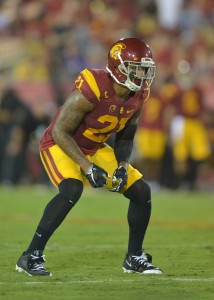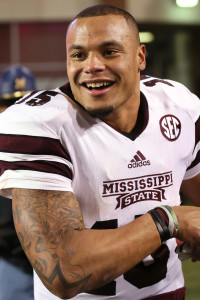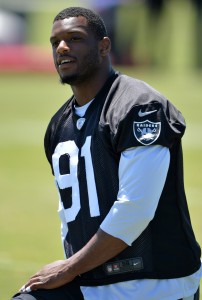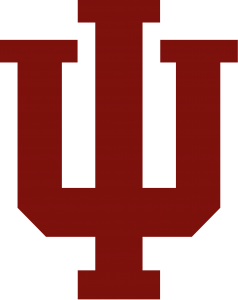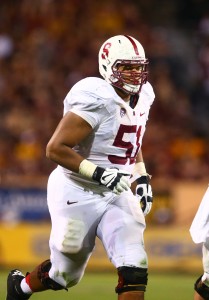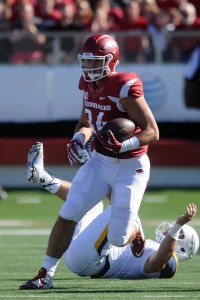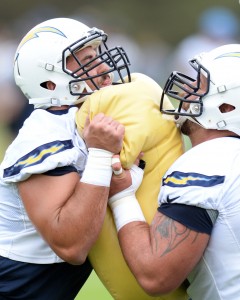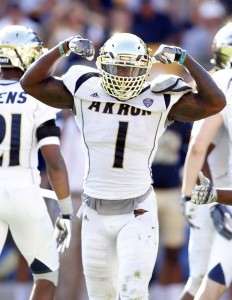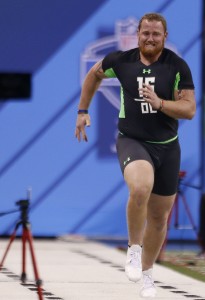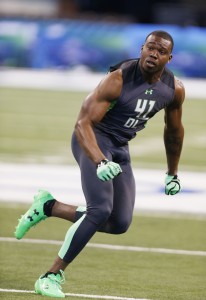Impact Rookies: Washington Redskins
The old adage that defense wins championships may or may not be true, but you’ll be hard-pressed to find a title-winning team that didn’t build heavily through the draft. Rookie classes, naturally, are evaluated on the perceived upside of the NFL newcomers, but which rookies are ready to contribute right out of the gate? And, how do they fit in with their new team schematically?
To help us forecast the immediate future of these NFL neophytes, we enlisted the help of draft guru Dave-Te Thomas who has served as a scouting personnel consultant to NFL teams for multiple decades.
First Round – Josh Doctson, WR (TCU, No. 22 overall)
Washington knew it was their defensive unit that needed the most immediate help, but in the opening round, finding a precise route runner like Josh Doctson still available was just too good for the team to pass up. While most analysts felt the Redskins would go for secondary help with the 22nd overall selection, the arrival of the TCU standout could make the 2016 season the final one for either Pierre Garson or DeSean Jackson – or both. The selection of Doctson broke the hearts of Minnesota and Cincinnati, picking right after Washington. Both teams did not make it a secret that they both coveted the services of the Horned Frog. 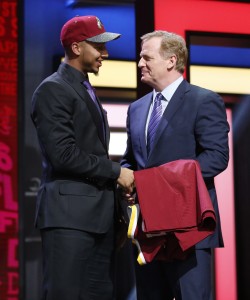
Doctson saw injuries sideline him at the end of the year, as he underwent wrist surgery. He sat out the final two regular season contests vs. Oklahoma and Baylor before returning briefly in the Alamo Bowl, but he was a non-factor vs. Oregon. Ultimately, he was one of three finalists for the Biletnikoff Award (nation’s top receiver) and garnered first-team All-American honors.
Doctson eased his way into the Horned Frogs lineup for six games in 2013, as he managed to pull in 36 balls for a 12.2-yard average. Based on that debut, few could have imagined that he would begin his two-year tear through the school record books. Perhaps due to league politics, Texas Christian officials were just as puzzled as our staff was when it was announced in 2014 that Doctson was only named to the league’s second-team postseason squad.
Doctson has a rangy, angular build with long arms and legs. Has a frame built for quickness – split high, lean and well-defined with big hands. He might lack the bulk desired from today’s flankers, but he shows good upper body muscle tone, tight waist and hips, good arm length and hand width, tapered thighs and calves, along with a good bubble.
He lacks outstanding speed, but Doctson is a smooth route runner with the ability to stretch the field and separate, along with the natural hands needed to make the difficult catches. He displays above average balance and crisp change of direction agility to gain valid yardage after the catch and has the ability to extend while tip-toeing along the sidelines for the soft pluck. He does a good job of gaining separation off the snap due to his initial quick step. The thing you see on the field is his natural feel for making adjustments on the move, displaying good fakes and a bit of con in him to set up defensive backs in attempts to get open. He does a very nice job of sitting down and uncovering, allowing with showing good boundary awareness to keep his feet working along the sidelines. He also shows very good vision to separate after the catch. While he’ll have some adjusting to do at the next level, Doctson offers certain tools and instincts that you wouldn’t typically expect to see out of a rookie.
Continue reading about the Redskins’ rookie class..
Impact Rookies: Dallas Cowboys
The old adage that defense wins championships may or may not be true, but you’ll be hard-pressed to find a title-winning team that didn’t build heavily through the draft. Rookie classes, naturally, are evaluated on the perceived upside of the NFL newcomers, but which rookies are ready to contribute right out of the gate? And, how do they fit in with their new team schematically?
To help us forecast the immediate future of these NFL neophytes, we enlisted the help of draft guru Dave-Te Thomas who has served as a scouting personnel consultant to NFL teams for multiple decades.
The Cowboys hope that their 2016 draft cache performs as well as their 2015 draft version, rather than resemble the motley crew they selected in the 2014 phase. The 2015 draft class saw each of their six choices contribute, with first rounder Byron Jones looking like the long-range solution at free safety and fourth rounder, Damien Wilson, a wild card to take home first-team honors either at the weak-side (Sean Lee injury history) or in the middle (where Andrew Gachkar resides and where Rolando McClain was expected to patrol).
The team might need to recruit a drug czar, as they will see McClain, 2015 second-round rush end Randy Gregory, and 2014 second-round defender Demarcus Lawrence all having extended vacations this year due to their endeavors off the field. The 2014 draft did produce two quality starters in All-Pro guard Zack Martin and strong-side linebacker, Anthony Hutchins, but they have nothing of note to show for their other seven selections that year.
Star running back Ezekiel Elliott is expected to make Cowboys fans remember the glory days of Emmitt Smith, but he also has a dark cloud hanging over him after arriving in camp amid domestic abuse allegations. If Elliott gets cleared of alleged charges, the backfield could have a whole new look, as the staff is quietly touting sixth round Eastern Michigan tailback Darius Jackson as someone who will at least make “some noise” for the special team units.
It would have been nice if the team had taken a wide receiver, particularly the one the staff wanted in Ohio State’s Jalin Marshall. From early talk out of Jets camp, it appears Marshall could be the Green Nation’s biggest find in camp. Still, they did add some much-needed youth at quarterback late in the draft. Here’s a closer look at the two rookies I really like out of Dallas’ class this year:
First Round – Ezekiel Elliott, RB (Ohio State, No. 4 overall)
While Derrick Henry captured the 2015 Heisman Trophy, it was unanimous within the scouting industry that no tailback would be selected before Elliott in the draft. In fact, most scouts felt that the Buckeyes standout was the only running back worthy of first round consideration. In three seasons at the university, the football legacy has proven to be one of the best playmakers in the game. 
After beginning his Ohio State career as a reserve, Elliott became an immediate crowd pleaser once he stepped into the starting lineup two years ago. During his two seasons with the first unit, he amassed 3,699 yards on 562 carries (6.58 ypc) that included 41 touchdowns, adding 426 yards via 55 receptions (7.75 ypc). He would record 22 100-yard rushing performances, which rank second in school history behind Archie Griffin’s 34 such performances (1972-75). Among those 22 successful century-yard games, he gained at least 200 yards five times, tying the Ohio State record first set by Eddie George (1994-95).
While those numbers are impressive, Elliott also excelled at moving the chains. On 510 non-touch-down carries since he became a starter, it took multiple defenders to bring him down on 125 of those attempts (24.51%). He recorded 90 successful runs that were downed inside the red zone, including 37 within five yards of the goal line. In addition to his 41 touchdown runs, he had crucial carries that helped set up 25 other touchdown drives and four possessions that resulted in field goals.
Unlike most college ball carriers, Elliott has excellent receiving ability. Putting his 4.47 speed and natural hands to good use, he caught 55-of-59 targeted passes (leads the draft’s running backs with a 93.22% success rate) for 426 yards, setting up four touchdown drives and one field goal. Eighteen of his receptions gained at least ten yards and he recorded nineteen first downs as a receiver, including converting eight third-down tosses and another on a fourth-down play.
Elliott is a downhill runner, but he also has very loose hips, quick change of direction, and good power that he combines with nimble feet and excellent running balance. He shows superb agility with his pick-and-slide and the hip flexibility to easily redirect to the cutback lanes. He has impressive acceleration into the second level and unlike most big backs, do not label him as a one-cut runner, as he is quite capable of eluding or running through tackles.
The Ohio State product has very good leg drive and initial quickness for his position. He shows very good vision ability and does a nice job of sliding through the hole. He is a strong runner that can break arm tackles. He also shows he can break free for a big gain, though he lacks that second gear/home run speed. With an explosive stride, he shows that instant acceleration once he clears the line of scrimmage (see 2015 Virginia Tech, Indiana, Michigan and Notre Dame contests). Behind this stellar Dallas line, Elliott can be a real star for Dallas right away.
Click here to continue reading about the Cowboys’ rookies..
Impact Rookies: Oakland Raiders
The old adage that defense wins championships may or may not be true, but you’ll be hard-pressed to find a title-winning team that didn’t build heavily through the draft. Rookie classes, naturally, are evaluated on the perceived upside of the NFL newcomers, but which rookies are ready to contribute right out of the gate? And, how do they fit in with their new team schematically?
To help us forecast the immediate future of these NFL neophytes, we enlisted the help of draft guru Dave-Te Thomas who has served as a scouting personnel consultant to NFL teams for multiple decades.
Today, we continue PFR’s Impact Rookie series with his insight on the Oakland Raiders’ draft class:
Oakland or Las Vegas? Wherever the Raiders end up playing, both their offensive and defensive foundations are well on their way to being established, as quarterback Derek Carr and left defensive end Khalil Mack were efficient and sensational, respectively, during their second campaign in the league last year.
This is a young team on the rise, a team that returns all but three of the players who started for them in 2015. The front office opened their wallets and brought in help for the secondary, pass rush and offensive line that should see the organization increase their playoff chances. Established pass protector Kelechi Osemele left Baltimore to provide the Raiders with a drastic upgrade at the left guard spot manned by departed J’Marcus Webb (Seattle) last year. With Webb, the front wall yielded 38 sacks and saw their ground attack limp to 91.1 yards per game last season, the fifth lowest average in the league.
Even with future Hall of Fame safety Charles Woodson in charge, the defense gave up 258.3 aerial yards per game, the 25th-highest total in the NFL. They tied for 13th with just fourteen interceptions, but replace Woodson with Cincinnati’s Reggie Nelson, who tied for the league title with eight pass thefts last year, along with finishing sixth in the NFL with 22 passes defended and ranked second on the Bengals squad with 77 tackles. Nelson is also a great veteran mentor for first round safety, Karl Joseph, who should be ready to start by the season opener after an injury-marred 2015 campaign at West Virginia.
First Round – Karl Joseph, SS (West Virginia, No. 14 overall)
The team’s first-round draft pick is still working hard trying to get his surgically repaired right knee ready for the rigors of training camp. Hurt in a non-contact drill in early October, the slight-framed strong safety compensates for his lack of ideal size and bulk with tremendous force behind his hits. While those bone-rattling tackles will excite the fan base, it will also alert the refs, as Joseph’s penchant for getting too aggressive have led to the flags being thrown on a regular basis. While penalties in bunches were the norm for the Raiders in the past, the defense “wised up” last year, ranking 23rd in the league with just 104 penalties for the unit. 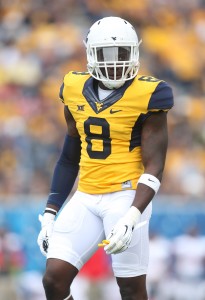
At the time of his injury, Joseph was leading the major college ranks with an average of 1.3 interceptions per game and paced the Big Twelve Conference with an average of 1.5 passes defended per contest. He had a career-high three interceptions vs. Georgia Southern last year, the first Mountaineer to accomplish that feat since 1994.
Joseph graduated in December with academic honors and was the team’s “valedictorian” on the gridiron, where he had started 42-of-44 games during his career. He recorded eight interceptions while deflecting twelve passes, delivering 284 tackles (209 solos) with a pair of sacks and 15.5 stops-for-loss. His hard-hitting style caused eight fumbles, which he recovered six of them.
Despite lacking great bulk, Joseph possesses good upper body thickness, large, natural hands (9 ¾-inches) and room to carry at least another ten pounds of bulk for a potential move to strong safety at the next level. He lacks blazing quickness (4.59 in the 40-yard dash), which will limit his position duties to the strong-side slot. While he has good range, there is a bit of stiffness in his hips when he attempts to transition (note-prior to his injury in 2015, Joseph was working on how to compensate for some hip stiffness with a short stride to help him open his hips quicker in transition), but he shows good ability to plant-&-drive, coming out of his breaks cleanly. He seems to play better when making plays in front of him, as he lacks the second gear to recover when trying to stay with the speedy receivers on deep routes.
Joseph is an emotional team leader who takes well to hard coaching. He has the field awareness to easily break down plays and locate the ball, doing a very good job of staying low in his pads and taking proper angles to close on and make the play. His field vision when playing in the shallow zone allows him to fill the rush lanes in an instant while breaking sharply on the ball in underneath passing situations. As a strong safety, he has shown that despite size issues, he can mirror the tight ends on underneath routes and shows good anticipation skills and awareness dropping back in the zone. Those fumbles caused are evident that he has a nose for the ball and the interception figures highlight his natural hands to make the interception.
Click here to read more about the Raiders’ rookie class..
49ers, Joshua Garnett Agree To Deal
The 49ers and first-round guard Joshua Garnett have reached an agreement on a contract, according to Matt Barrows of the Sacramento Bee. Adam Schefter of ESPN.com reported earlier Friday that the two sides were nearing a deal (Twitter link). With Garnett under contract, the Chargers’ Joey Bosa is now the last remaining holdout from the first round of this year’s draft.
As the 28th overall pick, Garnett should make upward of $9.3MM on his four-year pact, which includes a signing bonus in the $4.97MM neighborhood and a fifth-year option. Garnett was the second top-round selection the 49ers had this year. They grabbed ex-Oregon defensive end DeForest Buckner with the seventh choice before trading back into the first round for Garnett. In order to do that, the 49ers shipped three picks – a second-rounder (No. 37), a fourth-rounder (No. 105) and a sixth-rounder (No. 178) – to the Chiefs for No. 28 and a seventh-rounder (No. 249).
A former Stanford Cardinal, Garnett’s play last year earned him the Outland Trophy, which is given annually to the best interior offensive lineman in the nation, and consensus All-America honors.
“In our minds, he was the best run-blocking lineman in this draft,” 49ers general manager Trent Baalke said of the 6-foot-5, 325-pounder.
Garnett, whose father is former NFL nose tackle Scott Garnett (a 49er in 1985), could end up as San Francisco’s Week 1 starter at right guard, as Roster Resource shows. The 49ers’ starter for most of 2015, Jordan Devey, was among Pro Football Focus’ lowest-ranked guards and is now a member of the Chiefs. Of greater concern, the interior of the 49ers’ O-line took a notable pre-draft hit when longtime stalwart Alex Boone signed with the Vikings as a free agent.
Here’s a look at the 49ers’ 11-player draft class:
- 1-7: DeForest Buckner, DL (Oregon)
- 1-28: Joshua Garnett, G (Stanford)
- 3-68: Will Redmond, DB (Mississippi State)
- 4-133: Rashard Robinson, CB (LSU)
- 5-142: Ronald Blair, DE (Appalachian State)
- 5-145: John Theus, T (Georgia)
- 5-174: Fahn Cooper, OL (Ole Miss)
- 6-207: Jeff Driskel, QB (Louisiana Tech)
- 6-211: Kelvin Taylor, RB (Florida)
- 6-213: Aaron Burbridge, WR (Michigan State)
- 7-249: Prince Charles Iworah, DB (Western Kentucky)
Photo courtesy of USA Today Sports Images.
Joey Bosa Will Not Report To Chargers Today
Chargers first round pick Joey Bosa will not report with his teammates today as he remains unsigned, according to Steve Wyche of NFL.com (on Twitter). The timing of bonus payouts and offset language are believed to be the sticking points in negotiations.
[RELATED: Jets, Rookie Darron Lee Agree To Deal]
While Bosa’s battle with the Bolts over his rookie contract has been known for some time, few expected this dispute to drag into training camp. The No. 3 overall pick in this year’s draft seems serious about getting what he wants in his rookie deal and he is out to prove his point as he stays home today.
Bosa is obviously a big part of the Chargers’ plans for this season and his absence is undoubtedly frustrating for the team. Recently, in a PFR exclusive, scouting guru Dave-Te Thomas gave an in-depth look at Bosa and the rest of San Diego’s rookie class:
“Bosa is scheduled to start at left defensive end, where the Chargers let former second round pick, Kendall Reyes, also leave the complex to join Weddle in Baltimore. After a promising rookie year that saw Reyes tally 5.5 sacks, nine stops for loss and nineteen QB pressures, Reyes failed to impress during his three years as a starter, making two sacks and 32 hits through fifteen assignments with the first unit last year.
While Bosa only sealed the deal with five sacks in 2015, he did record fourteen QB chase-downs, including eight on third-down snaps and two on fourth-down plays. While he was effective as a pass rusher in 2014, he really has yet to develop an array of pass rush moves, relying more on his length and raw power to beat blocks on his path to the quarterback. He is known more for that power, but as he matures, he needs to be more efficient with his swim- and rip-move techniques. In any event, he can be an impact player for the Chargers in 2016 – once he gets his contract sorted out.”
Meanwhile, in San Francisco, guard Joshua Garnett stands as the only other remaining first-round holdout. Rapoport (on Twitter) hears that there probably won’t be a holdout from the No. 28 overall pick and a deal should get done shortly.
Photo courtesy of PFR on Instagram.
Jets Sign Darron Lee
9:07pm: The Jets have officially announced the signing.
3:14pm: Lee’s four-year, $10.2MM deal is fully guaranteed, but also includes default language that allows the Jets to recoup some of his guaranteed money if he is cut for non-football reasons, Rich Cimini of ESPN.com tweets.
2:36pm: The Jets’ longstanding contract dispute has finally come to an end (No, not that one). The Jets and first-round pick Darron Lee have reached agreement on a contract, Adam Schefter of ESPN.com tweets.
Reportedly, Lee was pushing for the fourth year of his contract to be fully guaranteed. Meanwhile, the Jets were only willing to give Lee a partial guarantee for the 2019 season.
Recently, scouting guru Dave-Te Thomas spoke highly of Lee when breaking down the Jets’ rookie class for PFR:
It is not etched in stone where Lee will line up for the Jets, but hailed by The NFL Draft Report the “best defensive playmaker in the 2016 draft,” the Jets are certain to find a role quickly for their first round pick. For now, he’s listed behind Erin Henderson at right inside linebacker. Beyond that, veteran and inside starter David Harris might be looking for employment elsewhere in 2017, if Lee progresses as quickly as expected.
Henderson moves into the lineup, at least temporarily, after the Jets let Demario Davis leave in free agency despite finishing second on the team with 90 tackles last year. Still, it will not be long before he cedes playing time to Lee. Another player greatly affected by Lee’s arrival is Buccaneers castoff Bruce Carter, who was brought in to play the nickel package. With Lee’s cornerback-like speed, Carter will have to sit while Lee performs in that alignment.
Some draft analysts stated that Lee was a “work in progress” and “did not excite” in 2015 like he did in 2014 during the Buckeyes’ national championship march. Unknown to many scouts, at the time, but Lee was playing with a lower leg injury during the first half of his sophomore campaign. With several Buckeyes suspended earlier in the year, the strong-side linebacker felt that even on one leg, he needed to be out on the field.
There are now only two first-round picks that are not under contract with their respective clubs. Chargers defensive end Joey Bosa and 49ers guard Joshua Garnett have yet to sign on the dotted line.
Photo courtesy of USA Today Sports Images.
Impact Rookies: San Diego Chargers
The old adage that defense wins championships may or may not be true, but you’ll be hard-pressed to find a title-winning team that didn’t build heavily through the draft. Rookie classes, naturally, are evaluated on the perceived upside of the NFL newcomers, but which rookies are ready to contribute right out of the gate? And, how do they fit in with their new team schematically?
To help us forecast the immediate future of these NFL neophytes, we enlisted the help of draft guru Dave-Te Thomas who has served as a scouting personnel consultant to NFL teams for multiple decades.
Today, we continue PFR’s Impact Rookie series with his insight on the San Diego Chargers’ draft class:
First Round – Joey Bosa, DE (Ohio State, No. 3 overall)
Is San Diego regretting their draft day surprise? Many felt that Jalen Ramsey was a perfect fit for the Bolts as he could have filled the free safety role. Instead, they passed on the best defensive player in the draft to take defensive end Joey Bosa. As camp approaches, Bosa and the front office are at an impasse over his contract. 
Bosa is scheduled to start at left defensive end, where the Chargers let former second round pick, Kendall Reyes, also leave the complex to join Weddle in Baltimore. After a promising rookie year that saw Reyes tally 5.5 sacks, nine stops for loss and nineteen QB pressures, Reyes failed to impress during his three years as a starter, making two sacks and 32 hits through fifteen assignments with the first unit last year.
[RELATED: Follow Pro Football Rumors On Instagram]
Bosa was suspended for the 2015 season opener and was slow to get back into his usual “bull in a china shop” self in 2015. Coming off a 12-sack, 21.0-tackle-for-loss 2014 national championship campaign, Bosa saw his numbers dip to five sacks in 2015. He did post sixteen stops behind the line of scrimmage, tying for 15th on the school season-record list, adding fourteen QB pressures. Eight of his tackles in the backfield came on third-down snaps and the opponents were held to a rushing average of 0.43 yards on plays directed at him. He would close out his career third in OSU annals with 26 sacks and fourth with 50.5 tackles-for-loss.
Bosa’s outstanding instincts shined throughout his career. He displays improvement in the strength department, as his body has begun to mature to NFL level. The first thing you notice on film is that he plays with a high motor and has excellent initial quickness to surprise the lethargic offensive lineman. He shows above average balance working down the line and in pursuit. He gains advantage with his sudden moves and change of direction agility, doing a nice job of using his hands and arm extension to avoid low blocks and maintain balance on the move. He is a quick twitch type of player with the natural movement skills to pursue from the backside, shooting the inside gaps, evident by his pass defense performance that flattened Christian Hackenberg on a fourth-and-5 play to secure a victory over Penn State in 2014. He shows good body control working down the line to take an inside gap as a bull rusher. He runs with a long stride, building acceleration nicely. He flashes initial quickness along with sudden explosiveness off the line to surprise a lethargic blocker, and on the move, he is not as quick to redirect.
While Bosa only sealed the deal with five sacks in 2015, he did record fourteen QB chase-downs, including eight on third-down snaps and two on fourth-down plays. While he was effective as a pass rusher in 2014, he really has yet to develop an array of pass rush moves, relying more on his length and raw power to beat blocks on his path to the quarterback. He is known more for that power, but as he matures, he needs to be more efficient with his swim- and rip-move techniques. In any event, he can be an impact player for the Chargers in 2016 – once he gets his contract sorted out.
Read more about the Chargers’ rookie class..
Impact Rookies: Kansas City Chiefs
The old adage that defense wins championships may or may not be true, but you’ll be hard-pressed to find a title-winning team that didn’t build heavily through the draft. Rookie classes, naturally, are evaluated on the perceived upside of the NFL newcomers, but which rookies are ready to contribute right out of the gate? And, how do they fit in with their new team schematically?
To help us forecast the immediate future of these NFL neophytes, we enlisted the help of draft guru Dave-Te Thomas who has served as a scouting personnel consultant to NFL teams for multiple decades.
Today, we continue PFR’s Impact Rookie series with his insight on the Kansas City Chiefs’ draft class:
It was far from exciting for Kansas City fans when the Chiefs introduced their cache from the recent NFL Draft. While some fans recognized the need to improve the pass protection up front after KC quarterbacks were sacked 46 times last year (tied for sixth worst in the league), rather than bulking up the offensive line, they first cut guard Ben Grubbs, let right tackle Jeff Allen sign a four-year deal with Houston, and then traded away the No. 28 pick to San Francisco, only to see the 49ers take one of the better guard prospects available – Stanford’s Josh Garnett. While the fans were clamoring for a big body in the first round, Kansas City did manage to secure from the 49ers their second round pick (No. 37 overall), a fourth round choice (No. 105), and a sixth round selection (No. 178 through Dallas) in this year’s draft during the exchange.
So what does KC have in Jones and the rest of its 2016 rookie class? Let’s dive in:
Second Round – Chris Jones, DE/DT (Mississippi State, No. 37 overall)
Several teams had Jones pegged as a late first round prospect, but the Chiefs see him as a capable edge rusher with the ability to slide inside when they go to a four-man front. Still, other teams felt that the junior would have been better served remaining in school and continuing his development for another year. In 2014, he posted 26 tackles, but just 3.5 of those stops came from behind the line of scrimmage. He shifted from the weak-side to strong-side tackle last season, picking up second-team All-American honors after he delivered 44 tackles, 2.5 sacks and 7.5 stops-for-loss. 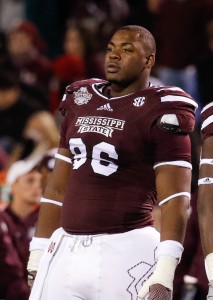
Jones might not have those eye-catching numbers you expect from an elite prospect, but even with 5.5 sacks combined his last two seasons, the Chiefs felt that he was further along than most of the defensive linemen still left in the draft. They realize that he needs refinement and lacks an array of pass rush moves, but he uses his hands exceptionally well to rip and swim. With his balance, he demonstrates the ability to execute an effective spin move, despite the fact that he tends to get high in his stance (he has a good center of gravity, though).
On film, you see that Jones’ high motor allows him to close in on a ball carrier quickly. Has a lot of range, makes a good portion of his tackles outside the box. With his balance, he gets out in space well, looking like an oversized linebacker. He’s quite light on his feet when he has to be, and you can see that he has that wiggle in his hips needed to make the last second moves to avoid the brunt of a blocker’s punch. When he keeps a low pad level, he generates much better explosion off the snap, but when he fails to deliver on his initial move, his feet stop and his arms get a little out of control at the point of attack, which allows blockers to get a piece of his jersey.
Still, for a player his size, he does a nice job of fitting into tight spaces. I doubt if he will ever be regarded as a pass rusher, as he is more suited in being a one-gap type of penetrator that can alter the lane of a running back. He must be conscious of low blocks though and has to do a better job of recognizing double teams, as failure to do so will result in Jones being driven back by that strong double team duo. In one-on-one battles, it is a completely different story, as the Bulldog uses his long arms and powerful hands to make it very difficult for a blocker to lock on to him, especially when he shows confidence in the power he delivers out his hands and arms.
Continue reading about the Chiefs’ rookie class..
Impact Rookies: Denver Broncos
The old adage that defense wins championships may or may not be true, but you’ll be hard-pressed to find a title-winning team that didn’t build heavily through the draft. Rookie classes, naturally, are evaluated on the perceived upside of the NFL newcomers, but which rookies are ready to contribute right out of the gate? And, how do they fit in with their new team schematically?
To help us forecast the immediate future of these NFL neophytes, we enlisted the help of draft guru Dave-Te Thomas who has served as a scouting personnel consultant to NFL teams for multiple decades.
Today, we continue PFR’s Impact Rookie series with his insight on the Denver Broncos’ draft class:
Even though Denver won the championship last season, you expect to see a great deal of changes for a team that relied heavily upon their defense to carry them into the playoffs. That unit, which ranked as the NFL’s leader in total defense (allowed 283.1 ypg) and pass defense (199.6 ypg) while ranking third against the run (83.6 ypg) lost two big contributors via free agency, including rush end Malik Jackson.
Speaking of the D-Line, the team made a strange move in the second round of the draft by taking Australian Adam Gotsis out of Georgia Tech. The Yellow Jacket’s technique failed to develop in college and he was viewed by most teams as just a strong man who can help support vs. the run, but also as a player with obvious pass rush deficiencies.
Gotsis, despite his power, was often stalled by combo blocks and reach blocks, rarely using his arms to escape from an offensive lineman’s clutches. He never really demonstrated much lateral agility and more often than not, he would lose sight of the ball carrier before the opponent hit the cut back lanes and showed marginal wrap-tackle skills. Gotsis has not played football since late October due to a torn ACL, making the selection even more puzzling.
Harder to replace is defensive tackle leader, inside linebacker Danny Trevathan (109 hits, two pass thefts, eight break-ups) who bolted for Chicago, where he is reunited with some of his former coaches from past Broncos seasons. Todd Davis is penciled in as his replacement, but he comes to the first unit with just 21 tackles and two career starting assignments. A former blue chip prospect whose off-field exploits resulted in a suspension while at Oklahoma, could rookie free agent Frank Shannon be the “wild card” to squash Davis’ first unit aspirations? It’s something to keep an eye on.
The offensive line was a constant problem and three of their Super Bowl starters – left tackle Ryan Harris, left guard Evan Mathis ,and right guard Luis Vasquez were jettisoned after the season. The team also traded away former left tackle starter Ryan Clady, bringing in Seattle’s Russell Okung to play the demanding position. Max Garcia, a 2015 fourth round find, takes over at left guard, but the team has a big question mark that they hope this year’s fifth round pick, Connor McGovern, could fill at the right guard position. Ouch!
I wasn’t thrilled with every pick the Broncos made this year, but these rookies could be contributors right off the bat:
Fourth Round – Devontae Booker, RB (Utah, No. 136 overall)
Ronnie Hillman led the team in rushing last year but he had to share time with C.J. Anderson, starting ten times against Anderson’s six starts. Hillman might be seeing the writing on the wall, as the front office determined that Anderson was worth a four-year deal. Still, neither player should rest easy with the training camp depth chart now that Booker is in the mix. Until he suffered a knee injury during the second half of the 2015 schedule, Booker was considered to be the best senior running back prospect in the draft. If he can return to form, the Broncos could have their most powerful runner since Terrell Davis suited up for the Orange Crush.
In two seasons at Utah, Booker earned All-Pac 12 accolades. He became just one of just two Utah players ever to record back-to-back 1,000-yard rushing seasons and one of three to rush for 1,000 yards twice in his career. He set the school record for career rushing average (120.6) and tied the school record for career 100-yard rushing games (14). He also finished third in career rushing yards (2,773), fourth in career carries (560) and tied for sixth in career rushing touchdowns (21).
A few weeks after earning Pac-12 Player of the Week honors for his performance against California (267 all-purpose yards), Booker was forced to miss the final two regular season games and bowl action when he suffered a torn meniscus and bone bruise in his left knee against Arizona. Their was hope that Booker would at least be able to participate in the Senior Bowl on January 30th, but he did not gain medical clearance and was also an observer at the NFL Scouting Combine and Utah’s March 24th Pro Day.
Booker runs with very good balance, body control and loose hips. He has a quick short area burst and good footwork, doing a nice job of shifting his weight and staying low in his pads to slip through traffic into the second level. He generates good body lean, moves and fakes to con the defender and is very effective using his outstanding change of direction agility. In isolated coverage, he will generally win the foot race vs. second level defenders. He has swivel hips, rather than veer and weave, doing a nice job of picking and sliding trying to find daylight.
Booker is the type that can generate an explosive and sudden burst into the crease, as he has that low center of gravity that remind old time scouts of former Jets tailback Freeman McNeil. He has outstanding vision and stop-and-go action to freeze the defender and is a slippery runner through the holes. He runs with great balance and flashes good quickness on the move. He might not be able to simply fly past an opponent, but he can quickly pick and slide through trash and is a fast-twitched type who has no problem negotiating through even the tiniest of creases.
Booker has excellent change of direction agility and body control. He is very effective when taking the pitch and having time to scan the field. He is the type that can create quite a bit on his own, but also is patient following his blocks. He does a very good job of adjusting on the move and with his shiftiness in and out of his cuts, he can get past the second level consistently. He has good lower body strength to break tackles and it is rare to see him go down on the initial hit.
Booker bounces outside with good urgency. He has superb outside vision and can get to his top-end speed to take the ball to the house turning the corner. He moves well as an option running back, also, where he is able to capitalize on his balance and foot work. He has a very good feel for the cutback lanes, getting the bulk of his yardage when doing so. He might not have the timed speed to beat secondary defenders, but takes good angles and shows the head and shoulder fakes to take those opponents out of the play. With his body control, he excels at turning it up with his outside run.
Booker shows good hands for the passing game. He is fluid when trying to extend his hands away from the framework, especially when attempting to get to off-target tosses. He shows good concentration to look the ball in and is quick to turn and head up field after the catch. He has the body control to adjust to the ball in flight and has a very good feel for getting open on the screens.
Continue reading about the Broncos’ rookie class..
Impact Rookies: Cleveland Browns
The old adage that defense wins championships may or may not be true, but you’ll be hard-pressed to find a title-winning team that didn’t build heavily through the draft. Rookie classes, naturally, are evaluated on the perceived upside of the NFL newcomers, but which rookies are ready to contribute right out of the gate? And, how do they fit in with their new team schematically?
To help us forecast the immediate future of these NFL neophytes, we enlisted the help of draft guru Dave-Te Thomas who has served as a scouting personnel consultant to NFL teams for multiple decades.
Today, we continue PFR’s Impact Rookie series with his insight on the Cleveland Browns’ draft class:
Whether the formula works, or not, Cleveland came out of the draft after making a flurry of trades with fourteen youngsters to vie for roster spots. By trading down from the second overall spot, the Browns definitely added quantity, but you can see that they still have a primary need – quarterback. The Eagles packaged a deal with the Browns and went home happy with their quarterback catch in North Dakota’s Carson Wentz. Meanwhile, Cleveland invested $15MM in a quarterback who could go down as one of the biggest draft day mistakes ever, Washington castoff Robert Griffin III.
For a sum of $15,072,000 in 2016, Cleveland enters training camp with a quarterback stable that includes Griffin (7.5 mil), Josh McCown (4.7 mil), Austin Davis ($2.025 mil) and Cody Kessler (847K). While the coaches are saying all nice things about Griffin coming out of mini camp, one has to wonder if they’re not sold on him since they also kept McCown.
By the time the team was able to pick in the first round, they were not in love with the quarterback left behind (Paxton Lynch) and went after filling their second-biggest need at wide receiver, bringing in the electrifying Corey Coleman. The Browns stepped away from the usual “best available athlete” draft mode used by most teams, as they went for needs with their first four selections. Checking off the big need at receiver with Coleman, UCLA’s Jordan Payton and Colorado State’s Rashard Higgins, the team turned their attention to the defensive line that featured one of the worst sack units in the league.
In fact, they doubled down at the defensive end position, first, taking Oklahoma State’s Emmanuel Ogbah in the second round, followed by Penn State sack artist Carl Nassib in the next phase. There is talk of turning Ogbah into an outside linebacker, rather than playing him on the front wall, but the team should look back at their recent draft history to see how they utterly failed in their attempts to convert Barkevious Mingo, the team’s first pick in the 2013 draft, into a stand-up second level performer.
That plan could change by training camp, as recent pectoral muscle surgery by Desmond Bryant will sideline the starting left end for four-to-six months. That could give both their second and third round selections great opportunities to join the first unit. Early money says it will be Nassib, who rocked the backfield to the tune of 15.5 sacks during his breakout 2015 season. Ogbah chipped in with thirteen sacks and nineteen quarterback pressures. Last year, Cleveland finished with 29 sacks, which ranked 28th in the NFL.
When you look at the Browns’ entire draft picture, unless the first four players contribute immediately, if could be a head scratcher by the end of the season and yet another front office blow up. They invested a fourth round pick in Princeton tight end Seth DeValve, who was rated no better than the 47th-best tight end in the draft on most war room boards. He enters camp listed fourth on the depth chart and will battle five other tight ends for what will likely be three spots on the roster. The rest of their draft picks might be the perfect formula to put an insomniac to sleep.
There are plenty of question marks in this group, but these players could put exclamation points on their frosh seasons in the NFL:
First Round – Corey Coleman, WR (Baylor University, No. 15 overall)
Whether it is a fellow former Baylor Bear at quarterback or the aging veteran (perhaps the rookie from USC can make some noise later in the year, if all else fails), the Browns knew they could not go into the season with their obvious lack of depth at the wide receiver position. Knowing they needed a playmaker who could replace the 68 receptions recorded by Travis Benjamin, who left via free agency, their logical choice was Coleman, preferring the little speedster over other blue chip first round talent like Will Fuller, Josh Doctson, and Laquon Treadwell. 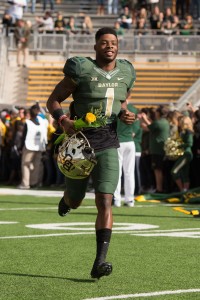
Sports hernia surgery prevented the Bears prospect from playing past the 2015 regular season schedule, but despite missing bowl action, he pulled in 74-of-127 targeted passes (58.27%), as he had twelve passes batted away from him and dropped four others. Even though Baylor quarterbacks often misfired (37 targeted passes to Coleman failed to reach him), his 74 grabs rank fifth on the school season-record list. He finished ninth in the NCAA Football Bowl Subdivision ranks with 1,363 receiving yards and he led the nation with a school-record 20 touchdown catches, shattering the previous mark of fourteen by Kendall Wright in 2011.
Among Coleman’s 74 receptions, he recorded 47 first downs (63.51%), converting 9-of-17 third-down opportunities. He gained at least ten yards on 38 grabs, including going distances of 20 yards or longer on 20 of those receptions. In addition to his 20 touchdowns, he had key catches to set up five other touchdown drives.
[RELATED: Browns Have No Plans To Cut Isaiah Crowell]
After he generated 216 yards behind eleven receptions in the Kansas State contest, Coleman started to feel the effects from a nagging groin injury. During the course of his next four appearances, he failed to reach the end zone and averaged 46.25 yards per game on a total of sixteen catches. The sports hernia discovery would keep him out of action vs. North Carolina in the Russell Athletic Bowl. Soon after, Coleman announced that he would not be returning to school in 2016 and had entered the draft.
Coleman’s best asset is his timed speed, as he has more than enough quickness to elude in the open field, with adequate strength to fight for the ball in a crowd. He is the type of player that teams covet – one with the rare playing speed to stretch the defense, showing the burst needed to beat angles. He demonstrates excellent athleticism for his position, as few opposing defenders can mirror him on deep routes due to his speed. He not only has the speed to threaten the deep secondary – he also has the body control, lateral quickness, and change of direction agility to make the underneath catches.
The former Baylor star he has good eyes for locating the soft areas to settle in and shows good awareness for the comebacks. He is quick to recognize coverage and adjust to what the secondary gives him. He also is alert enough to know when he has to work back to the ball, especially when dealing with an erratic quarterback. Coleman is a classic deep threat, used mostly to stretch the field. He gives good effort working underneath, but there are still times when he will short arm when going for the ball over the middle or when facing the quarterback.
He can make some noise in 2016, particularly if Gordon is not reinstated.
Continue reading about the Browns’ rookie class..

